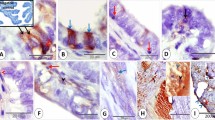Summary
The role of enzymatic collagen degradation in prostaglandin-induced and physiological cervical ripening was studied by determining collagenase and other proteolytic activity in extracts of cervical biopsies. Collagenase activity was assayed in a highly specific and sensitive system using native collagen type I as substrate. The intracervical application of sulprostone gel prior to termination of 1st trimester pregnancy led to a marked improvement in cervical dilatability. Collagenase and proteolytic activity were found to be significantly higher in postpartum samples than in specimens obtained from the nonpregnant or early pregnant cervix. After sulprostone treatment enzymatic activities were only marginally elevated. Analysis of extractable peptides showed that sub partu collagen was degraded in preference to noncollagenous proteins into very small fragments, whereas in the process of prostaglandin-induced cervical ripening collagen degradation appears to be of minor importance.
Similar content being viewed by others
References
Abe S, Nagai Y (1973) Evidence for the presence of a complex of collagenase with α2-macroglobulin in human rheumatoid synovial fluid: a possible regulatory mechanism of collagenase activity in vivo. J Biochem [Tokyo] 73:897–900
Adelmann BC, Kirrane JA, Glynn LE (1972) The structural basis of cell-mediated immunological reactions of collagen. Immunology 23:723–738
Adelmann-Grill BC (1982) Säugetierkollagenasen: physiologische und pathologische Aspekte. Arzneimittelforsch 32:1357–1362
Anson ML (1938) The estimation of pepsin, trypsin, papain and kathepsin with hemoglobin. J Gen Physiol 22:79–89
Cawston TE, Murphy G, Mercer E, Galloway WA, Hazleman GL, Reynolds JJ (1983) The interaction of purified rabbit bone collagenase with purified rabbit bone metallo proteinase inhibitor. Biochem J 211:313–318
Harris E, Krane S (1974) Collagenase. New Engl J Med 291:557–563
Huszar G, Naftolin F (1984) The myometrium and uterine cervix in normal and preterm labor. N Engl J Med 311:571–581
Kitamura K, Ito A, Mori Y (1980) The existing forms of collagenase in the human uterine cervix. J Biochem [Tokyo] 87:753–760
Kleissl HP, van der Rest M, Naftolin F, Glorieux FH, de Leon A (1978) Collagen changes in the human cervix at parturition. Am J Obstet Gynecol 130:748–753
Krieg T, Hörlein D, Wiestner M, Müller PK (1978) Aminoterminal extension peptides from type I collagen normalize excessive collagen synthesis of scleroderm fibroblasts. Arch Dermatol Res 263:171–180
Kühnle H, Grande P, Kuhn W (1977) Vermeidung dilatationsbedingter Komplikationen beim Schwangerschaftsabbruch durch intrazervikale Applikation eines prostaglandinhaltigen Gels. Geburtshilfe Frauenheilkd 37:675–680
Laemmli UK (1970) Cleavage of structural proteins during the assembly of the head of bacteriophage T4. Nature [Lond] 227:680–685
Lowry OH, Rosebrough NJ, Farr AL, Randall RJ (1951) Protein measurement with the folin phenol reagent. J Biol Chem 193:265–275
Maillot v K, Zimmermann BK (1976) The solubility of collagen of the uterine cervix during pregnancy and labor. Arch Gynecol 220:275–280
Maillot v K, Stuhlsatz HW, Mohanaradha Krishnan V, Greiling H (1979) Changes in the glycosaminoglycans distribution pattern in the human cervix during pregnancy and labor. Am J Obstet Gynecol 135: 503–506
Maillot v K, Stuhlsatz HW, Gentsch HH (1981) Connective tissue changes in the human cervix in pregnancy and labour. In: Ellwood DA, Anderson ABM (eds) The cervix in pregnancy and labor. Livingstone, Edinburgh London Melbourne New York, p 123
Mori Y, Ito A, Hirikawa S, Kitamura K (1981) Proteinases in the human and rabbit cervix. In: Ellwood DA, Anderson ABM (eds) The cervix in pregnancy and labour. Livingstone, Edinburgh London Melbourne New York, p 136
Rath W, Meyer D, Hildebrandt J, Hilgers R, Kuhn W (1983) Comparative study of various intracervically administered PG gel preparations for termination of first trimester pregnancies. Contraception 28:209–222
Rath W, Meyer D, Harder D, Hilgers R, Kuhn W (1985) Cervical ripening in first trimester abortion by intracervical application of sulprostone gel. Geburtshilfe Frauenheilkd 45:51–56
Stricklin GP, Bauer EA, Jeffrey JJ, Eisen AZ (1977) Human skin collagenase: isolation of precursor and active forms from both fibroblast and organ culture. Biochem J 16:1607–1615
Stricklin GP, Welgus HG) Human skin fibroblast collagenase inhibitor. Purification and biochemical characterization. J Biol Chem 258:12252–12258
Szalay S, Husslein P, Grünberger W (1981) Die kollagenolytische Aktivität von menschlichem Zervixgewebe nach lokaler Applikation von Prostaglandin E2 (PGE2) mit einem Portioadapter. Zentralb Gynäkol 103:1107–1112
Uldbjerg N, Ekman G, Malmström A, Sporrong B, Ulmsten U et al. (1981) Biochemical and morphological changes of human cervix after local application of prostaglandin E2 in pregnancy. Lancet I:267–268
Uldbjerg N, Ekman G, Malmström A, Olsson K, Ulmsten U (1983) Ripening of the human uterine cervix related to changes in collagen, glycosaminoglycans, and collagenolytic activity. Am J Obstet Gynecol 147:662–666
Uldbjerg N, Ulmsten U, Ekman G (1983) The ripening of the human uterine cervix in terms of connective tissue biochemistry. Clin Obstet Gynecol 26:14–26
Uldbjerg N, Ekman G, Malmström A, Ulmsten U, Wingerup L (1983) Biochemical changes in human cervical connective tissue after local application of prostaglandin E2. Gynecol Obstet Invest 15:291–299
Welgus HG, Jeffrey JJ, Eisen AC, Roswit WT, Stricklin GP (1985) Human skin fibroblast collagenase. Interaction with substrate and inhibitor. Collagen Rel Res 5:167–179
Wooley DE, Roberts DR, Evanson JM (1975) Inhibition of human collagenase activity by a small molecular weight serum protein. Biochem Biophys Res Comm 66:747–754
Author information
Authors and Affiliations
Additional information
Investigations presented here are part of a not yet submitted dissertation of U. Pieper
Rights and permissions
About this article
Cite this article
Rath, W., Adelmann-Grill, B.C., Pieper, U. et al. Collagen degradation in the pregnant human cervix at term and after prostaglandin-induced cervical ripening. Arch Gynecol 240, 177–184 (1987). https://doi.org/10.1007/BF00207713
Issue Date:
DOI: https://doi.org/10.1007/BF00207713




